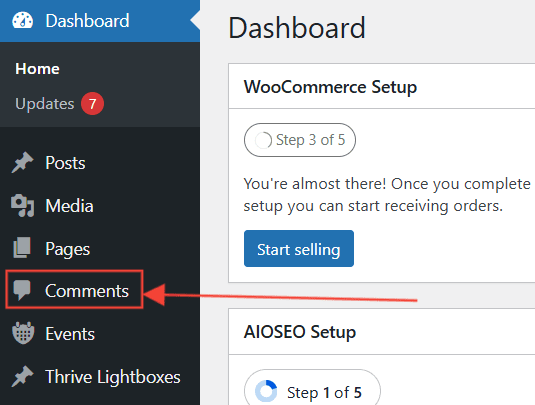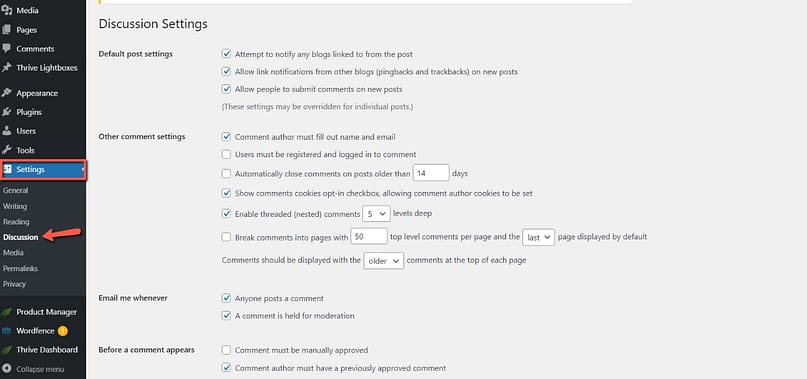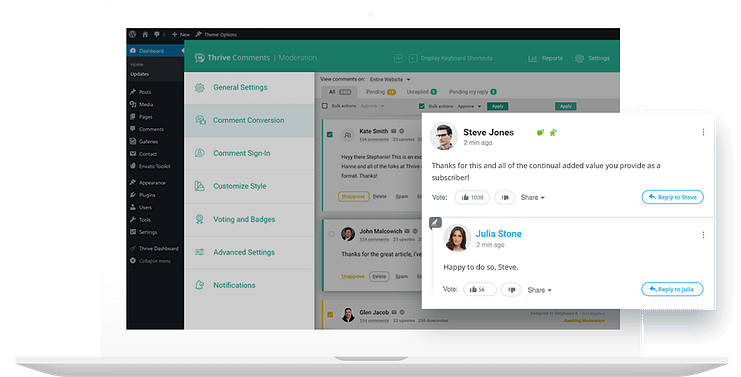Before you can decide what to do with comments, you need to know how to handle them.
I’ve seen creators spend hours crafting content only to let their comments section become a digital wild west — half spam, half silence. It doesn’t have to be that way.
When you understand how WordPress comments actually work — how to approve, reply, filter, or turn them off — you take back control of your space. You set the tone for real conversations, not chaos.
This guide walks you through how to manage comments in WordPress step-by-step, and then takes it further — into the part I love most — turning those conversations into something that drives connection, credibility, and conversions.
Getting Comfortable with WordPress Comments
Before we start clicking through settings, let’s get on the same page. I’m using the self-hosted WordPress.org dashboard (the one you install on your own hosting).
If you’re using WordPress.com, your menus may look a little different — so don’t panic if something’s in a new spot.
Think of the comments section as your blog’s public inbox. Every opinion, compliment, and spam pitch lands here first. When you learn how this space works, it stops feeling chaotic and starts becoming a real asset for your brand.
Click the toggles below to learn more.
Everything lives under Dashboard → Comments.
That page is your control center. You’ll see five tabs at the top:

- All – every comment that exists on your site.
- Pending – comments waiting for your review.
- Approved – the ones already visible on your posts.
- Spam – messages flagged as junk.
- Trash – comments marked for deletion.
Hover your mouse over any comment and you’ll see quick options appear underneath:
Approve, Reply, Quick Edit, Edit, Spam, and Trash.
Need to handle dozens at once?
Select multiple comments using the checkboxes, open the Bulk actions menu, choose Approve or Move to Trash, and click Apply.
Go to Settings → Discussion.
This is where you decide how people can interact with your posts.

Two checkboxes save me the most time:
Comment must be manually approved – gives me total control.
Comment author must have a previously approved comment – lets regular readers post freely without babysitting every reply.
Together, they keep my site safe and welcoming.
Still in Settings → Discussion, scroll to the moderation tools:
- Comment Moderation – holds a comment in the queue if it contains a set number of links or flagged keywords. I keep mine at 1 link to block bot spam.
- Disallowed Comment Keys – instantly deletes anything with shady phrases, emails, or IPs.
These two fields are small but mighty — a built-in filter that saves you from wading through junk.
I like getting an email when a comment is held for moderation, but not when every single approved comment goes live — it keeps my inbox manageable.
Avatars (from Gravatar) show profile photos beside each comment. They make discussions more personal, so I usually leave them on.
In Short
Once you know where to find your comments, how to approve or delete them, and how to stop spam before it lands, WordPress starts to feel a lot less intimidating.
Now that you understand the basics, let’s move into the 5-Minute Setup — where we’ll put these tools to work.
How to Manage Comments in WordPress (5-Minute Setup)
Managing comments isn’t complicated — it just feels that way until someone shows you what everything does.
Give me five minutes, and you’ll know exactly how to approve, reply, or remove comments like a pro.
Step 1: Open Your Comment Dashboard
From your WordPress dashboard, head to Comments in the left-hand menu.
This is where every comment on your site lives — approved, pending, spam, and trash.

You’ll see a simple list view. Hover over any comment and a few quick options appear right underneath:
Approve, Reply, Quick Edit, Edit, Spam, and Trash.
✅ My routine:
I approve thoughtful comments.
I reply to readers who add value.
I trash anything irrelevant or automated.
I mark as spam when I spot link drops or fake names.
If you have dozens of comments, use the checkboxes to select multiple at once.
Open the Bulk actions menu, choose Approve or Move to Trash, and click Apply.
It saves an incredible amount of time.
Step 2: Set Your Discussion Rules
Next, open Settings → Discussion.
Think of this as your comment policy — the quiet rules that keep your space sane.

I recommend starting with these two settings:
Comment must be manually approved. This means nothing goes public until you’ve seen it.
Comment author must have a previously approved comment. Once someone’s proven they’re genuine, their next comment skips the waiting line.
This combo gives you control and keeps your regular readers happy.
You’ll also see a checkbox labeled Allow people to submit comments on new posts.
That’s your site-wide switch. Keep it on if you want open discussion; turn it off if you’re not ready for comments yet.
Step 3: Keep Spam in Check
Still in Settings → Discussion, scroll to the moderation tools.
This is where you can fight spam without extra plugins (though I’ll mention one later).
Comment Moderation – holds a comment for review if it contains a certain number of links or suspicious words. I keep mine at 1 link.
Disallowed Comment Keys – instantly trashes comments with words, emails, or IPs you list here. Perfect for blocking repeat offenders or obvious spam phrases like “work from home $$$.”
If you want extra protection, pair WordPress’s built-in filters with a spam plugin like Akismet or Antispam Bee — both work quietly in the background.
💡 Want to take spam prevention a step further?
Read our full guide on how to stop spam comments on WordPress.
It covers smarter moderation settings, plugin recommendations, and quick wins that keep your comment section clean — so you can focus on real conversations instead of deleting junk.
Step 4: Customize Notifications
Scroll down a little further and you’ll see Email me whenever…
I personally enable “a comment is held for moderation” so I never miss something important,
but I leave “anyone posts a comment” unchecked — no one needs that many emails.
Step 5: Check Your Avatars
The last part of this page deals with Avatars — those profile images next to each comment.
I keep them enabled because faces make conversations feel more personal.
If you’re aiming for a minimalist layout or faster page loads, you can turn them off.
Quick Recap
In under five minutes, you’ve:
Found your comment dashboard
Learned how to approve, reply, or delete comments
Set smart moderation rules
Blocked spam before it hits your page
Customized notifications to keep your inbox clean
That’s the foundation.
Now that your comments are under control, we can move on to the part that turns those small exchanges into real engagement — and even conversions.
Can Blog Comments Lead to More Traffic and Conversions?
The answer is yes and no – it’s not as straightforward as that.
If all a blog needed was 1000s of comments to land at the top of a Google search engine results page (SERP), chasing after thousands of comments would be business and blogger’s strategy.

But, it doesn’t work like that.
Think of it this way: your write a great article and it gets swamped with 500 - 1000 comments overnight. Unless your blog has Neil Patel-level pull — those comments aren’t legit.
Most of them are just spam. That's not exactly the engagement party you were hoping for. Search engines and real readers can spot spammy content from a mile away, and it doesn't do much for your blog's credibility.
On the flip side, what if each of your posts only gets a handful of good comments, say around 10 to 20, and they genuinely add something to the conversation? You have the chance to rev up the results of your content marketing strategy.
It shows there's a real, living community interested in what you have to say. And that? That's gold for attracting more visitors and getting them to stick around or even make a purchase.
Let’s Talk About the Drawbacks of Enabling Comments on Your Blog
If you’re still on the fence about adding a comments feature to your blog post – that’s okay. We get it.
Enabling blog commenting does have valid drawbacks to consider, like:
Time Management Challenges: Moderating comments can become a full-time job for blog owners, especially as their platforms grow.
Spam Overload: No matter how obscure or popular your blog is, spam comments will find their way to you. Such comments aren’t just annoying; they can detract from the quality of your blog and deter genuine engagement.
Negative Feedback: Not all comments will sing your praises. Some might critique your views, question your facts, or just be downright negative — even on a good post.
Potential for Toxicity: Unfortunately, the anonymity of the internet can lead to toxic types of comments. This not only creates an unwelcoming environment for readers but can also tarnish your blog’s reputation.
While these concerns are certainly something to think about, it's also true that the positives of enabling comments can outweigh these challenges. Engaging directly with your readers and building a community around your content are just a couple of the brighter sides waiting to be explored.
With that in mind, let’s gently pivot to our next section, where we'll dive into the advantages that might just sway your decision.
Now Look at the Pros of Allowing Comments on Your Blog
After looking at the challenges of managing a comments section, it's natural to hesitate. But before you decide, it's worth exploring the other side of the coin. There are quite a few reasons to allow comments on your blog — and the benefits may outweigh the cons. Let's take a closer look at what allowing comments can really do for your blog:

Better Engagement: Comments open up a direct line of communication with your readers, turning passive scrolling into active participation. It's a way to make your readers feel more involved and connected to your content.
Community Feel: A blog with an active comments section starts to feel like a little community. Readers sharing their thoughts and reactions can create a sense of belonging among your audience, centered around the topics you write about.
Insightful Feedback: Through comments, you get to hear what your readers really think. This feedback can be incredibly useful information, offering you new perspectives and ideas for future posts that will resonate even more with your audience.
SEO Perks: Comments can give your blog a nice little boost in search engine rankings. Every new comment adds fresh content to your page, which search engines like to see.
Trust and Credibility: Showing that you're open to feedback and discussion can make your blog seem more trustworthy and credible. It signals to your readers that you value their input and are confident in your content.
While there's a bit of effort involved in managing a comments section, the connection, community, and insights it fosters can be well worth it. It's about turning your blog and nice articles into a space where readers feel seen and heard.
Great Tips for Managing Blog Comments Successfully
1. Use a Comment Moderation Plugin
The first step to successful comment moderation is having the right tools at your disposal.
This is where a comment moderation
plugin can make all the difference. And Thrive Comments is our top recommendation for WordPress websites.
Thrive Comments gives your default WordPress comments section a nicer look and more interactive functionality. Almost similar to a social media feed or forum — right on your own blog.
Think upvotes, downvotes, and recognition for those who are always in on the conversation. You can create a commenting system where everyone wants to jump in and share their point of view.
And it gets better.
When someone leaves a great comment, Thrive Comments lets you instantly engage with them. You can direct them to more content they might like or suggest signing up for your newsletter. This allows you to get the most out of the positive engagement your posts receive

In terms of moderation, Thrive Comments has your back. You can use this plugin’s dashboard to filter out keywords from frequent spammers, focus on comments on one specific post, and bulk delete or post comments in one go.
Tip: For a smoother experience, pair Thrive Comments with an anti-spam plugin like Akismet. This spam filter combination helps keep your comment section clean and focused on genuine engagement. If you don’t have a WordPress website, consider using a tool like Disqus.
2. Set Clear Guidelines
Before you even start receiving comments, establish clear rules about what is and isn’t acceptable in your comments section.
Make these guidelines visible to your readers to set expectations and help moderate discussions. State whether they should use their real names, use their Gravatar image, and if self-promotion is prohibited or not.
If your blog accepts comments in multiple languages (e.g. English, German, and French) this would be good to add in your guidelines.
3. Engage with Your Commenters Regularly
Make it a point to read and respond to comments regularly.
Engaging with your readers shows that you value their input and encourages more interaction. Even a simple acknowledgment can go a long way.
4. Encourage Positive Discussion
Promote a positive and respectful environment by leading by example.
Highlight constructive comments and engage in meaningful discussions. This sets the tone for your community and discourages negative behavior.
5. Deal with Negativity Appropriately
It’s inevitable to encounter negative or inappropriate comments.
Handle these situations with care – delete comments that violate your guidelines and constructively address misunderstandings or criticisms.
6. Highlight Top Contributors
Recognize and reward your most engaged readers. You can highlight their comments, feature them in your posts, or offer other forms of recognition.
This not only encourages more interaction but also builds a loyal community.
Bonus: How to Turn Comments into Conversions
Turning the comments section of your blog into a conversion tool is a clever way to engage with your readers and potentially increase your sales or subscriber list. Here are some strategies to help you make the most out of your comments:

- Give a Coupon Code: Reward your top commenters with a special coupon code for a discount on your products or services. It's a simple gesture that can make someone's day and potentially turn them into a customer.
- Redirect to a Welcome Page of Goodies: After a newbie leaves a comment, why not direct them to a page filled with exclusive content or offers? This can help build relationships with your brand.
- Link to a Survey or Quiz: This adds an interactive element. It's a win-win: you get valuable insights, and they get a more personalized experience.
- Gamify Your Comments: Introduce a point system, badges, or rewards for commenting. This gamification can encourage more interaction and make readers more likely to engage with your content and offers.
- Point to Related Blog Posts or Articles: Use comments as an opportunity to guide readers to other relevant content on your site — podcast episodes, other nice posts on your blog, a LinkedIn guide, etc.
- Use a Thank You Gift to Build Your List: Offer something valuable, like an ebook, free template, or an exclusive video, in return for their email address. It's a way to build your list while making your readers feel appreciated.

This approach is all about making connections that count. By adding these personal touches, you're not just boosting conversions; you're building a community around your blog. And you can easily enable any of these options in Thrive Comments.
This plugin provides settings to allow you to redirect your commenters to a page of your choice – giving you more room to turn your comments section into a mini-funnel of its own!
Next Steps: Create Engaging, SEO-Friendly Posts to Encourage Engagement
You can’t get good-quality, thoughtful comments from your readers without creating high-quality content.
Content is the cornerstone of your blog, and if it doesn’t resonate with your audience, you won’t see the engagement you’re aiming for. Here are four step-by-step tutorials to use to create great blog content and get your desired results:
Managing Comments On a Blog: It's Your Turn Now
Comment moderation doesn't have to be a chore. You just need the right tools and a simple system to engage with your audience and turn them into a raving community.
If you're ready to turn your default WordPress comments section into a better looking hub for conversation, you definitely need Thrive Comments.
This tool takes the hard work out of managing engagement on your blog, leaving you with more time to focus on content creation and the rest of your business.
Ready?




Thank you for this well-rounded guide! I was honestly unsure whether comments were worth the time, but you’ve convinced me that they can be a valuable tool for engagement and SEO. I also love the idea of rewarding top commenters with a coupon code—what a great way to encourage interaction while driving sales!